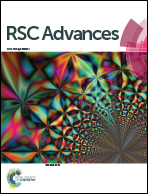Isatin N-phenylsemicarbazone: effect of substituents and concentration on anion sensing selectivity and sensitivity†
Abstract
The effect of substituent and concentration on anion sensing selectivity and sensitivity of nine new easily synthesized isatin N-phenylsemicarbazone E-isomer sensors IIIa–XIa was investigated. The substantial difference between the association constants for IIIa–XIa interaction with strongly and weakly basic anions allows detection of F− or CH3COO− anions even at high weakly basic anion excess. Substitution in position 5- of the isatin ring and para-substitution on the phenyl ring in the phenylsemicarbazide chain influence sensor : anion complex stoichiometry and thus also sensor sensitivity. Detection limits of 3–4 × 10−7 mol dm−3 for F− and CH3COO− anions by sensors IVa and Va bearing electron-withdrawing substituents are among the lowest published detection limits for these anions in organic solvents. The high selectivity and sensitivity of sensor VIa allows confident F− detection at tolerated fluoride drinking-water level. The solution dilution leads to a dramatic change in sensor selectivity. Consequently, one E-isomer can be used to sense both strongly and weakly basic anions. On the other side, higher sensor solution concentrations increase the F− and CH3COO− anion detection range, similar to the additional Z-isomer utilization.


 Please wait while we load your content...
Please wait while we load your content...